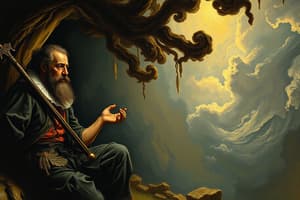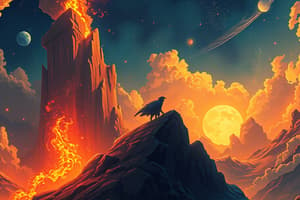Podcast
Questions and Answers
What is dramatic irony?
What is dramatic irony?
- When the main characters know something that the audience does not
- When the story is filled with suspense
- When the story ends tragically
- When the audience knows something that the main characters do not (correct)
How does situational irony differ from dramatic irony?
How does situational irony differ from dramatic irony?
- It always leads to a tragic ending
- It involves a subversion of expected outcomes (correct)
- It involves the audience knowing something the characters do not
- It is used primarily for creating suspense
In O. Henry’s 'The Gift of the Magi', what type of irony is portrayed?
In O. Henry’s 'The Gift of the Magi', what type of irony is portrayed?
- Dramatic irony
- Verbal irony
- Situational irony (correct)
- Socratic irony
What effect does irony have on storytelling?
What effect does irony have on storytelling?
In Othello, why is the audience aware of Iago's deceit while Othello is not?
In Othello, why is the audience aware of Iago's deceit while Othello is not?
Flashcards are hidden until you start studying
Study Notes
Irony in Literature
- Dramatic irony: a literary device where the audience knows something that the characters in the story do not, often creating a sense of tension or anticipation.
Types of Irony
- Situational irony: a contrast between what is expected to happen and what actually happens, often with a humorous or unexpected twist.
- Dramatic irony vs. situational irony: dramatic irony involves the audience's knowledge, while situational irony is a contrast between expectation and reality.
Examples of Irony
- The Gift of the Magi: O. Henry's story portrays situational irony, where a young couple sacrifices their most precious possessions to buy Christmas gifts for each other, only to find they cannot use them.
Irony in Storytelling
- Effect of irony: creates a sense of tension, anticipation, or surprise, engaging the audience and adding depth to the story.
Dramatic Irony in Othello
- Othello's unawareness: the audience is aware of Iago's deceit, while Othello is not, creating a sense of dramatic irony that heightens the emotional impact of the story.
Studying That Suits You
Use AI to generate personalized quizzes and flashcards to suit your learning preferences.




